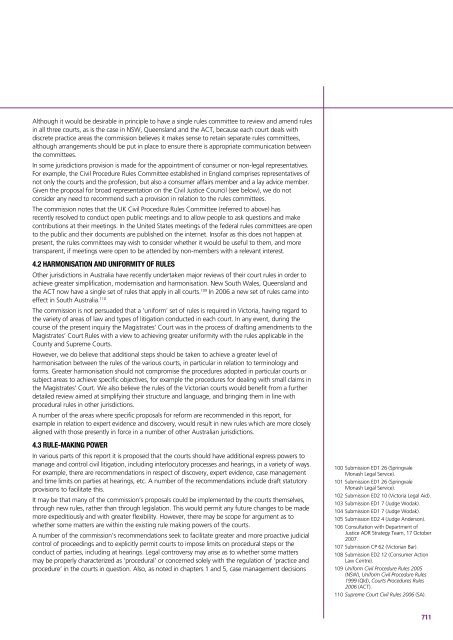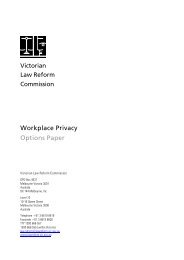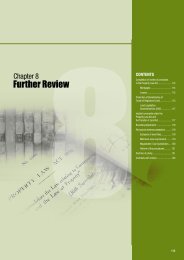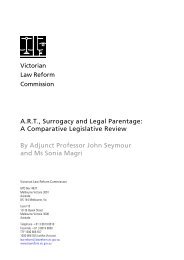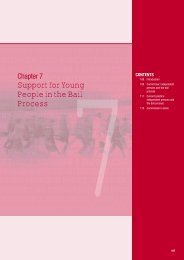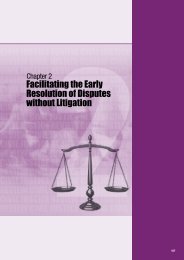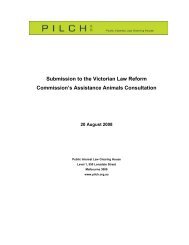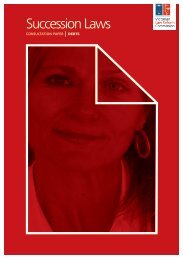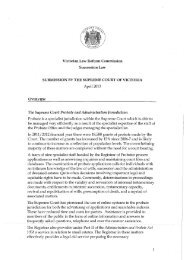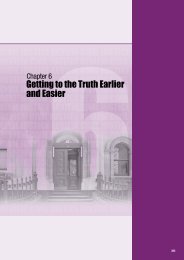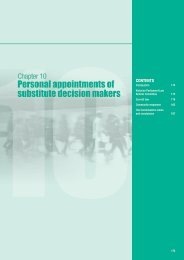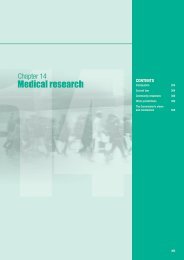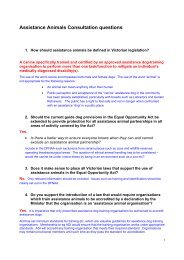12Facilitating Ongoing Civil Justice Review and Reform
12Facilitating Ongoing Civil Justice Review and Reform
12Facilitating Ongoing Civil Justice Review and Reform
You also want an ePaper? Increase the reach of your titles
YUMPU automatically turns print PDFs into web optimized ePapers that Google loves.
Although it would be desirable in principle to have a single rules committee to review <strong>and</strong> amend rules<br />
in all three courts, as is the case in NSW, Queensl<strong>and</strong> <strong>and</strong> the ACT, because each court deals with<br />
discrete practice areas the commission believes it makes sense to retain separate rules committees,<br />
although arrangements should be put in place to ensure there is appropriate communication between<br />
the committees.<br />
In some jurisdictions provision is made for the appointment of consumer or non-legal representatives.<br />
For example, the <strong>Civil</strong> Procedure Rules Committee established in Engl<strong>and</strong> comprises representatives of<br />
not only the courts <strong>and</strong> the profession, but also a consumer affairs member <strong>and</strong> a lay advice member.<br />
Given the proposal for broad representation on the <strong>Civil</strong> <strong>Justice</strong> Council (see below), we do not<br />
consider any need to recommend such a provision in relation to the rules committees.<br />
The commission notes that the UK <strong>Civil</strong> Procedure Rules Committee (referred to above) has<br />
recently resolved to conduct open public meetings <strong>and</strong> to allow people to ask questions <strong>and</strong> make<br />
contributions at their meetings. In the United States meetings of the federal rules committees are open<br />
to the public <strong>and</strong> their documents are published on the internet. Insofar as this does not happen at<br />
present, the rules committees may wish to consider whether it would be useful to them, <strong>and</strong> more<br />
transparent, if meetings were open to be attended by non-members with a relevant interest.<br />
4.2 Harmonisation <strong>and</strong> uniformity of rules<br />
Other jurisdictions in Australia have recently undertaken major reviews of their court rules in order to<br />
achieve greater simplification, modernisation <strong>and</strong> harmonisation. New South Wales, Queensl<strong>and</strong> <strong>and</strong><br />
the ACT now have a single set of rules that apply in all courts. 109 In 2006 a new set of rules came into<br />
effect in South Australia. 110<br />
The commission is not persuaded that a ‘uniform’ set of rules is required in Victoria, having regard to<br />
the variety of areas of law <strong>and</strong> types of litigation conducted in each court. In any event, during the<br />
course of the present inquiry the Magistrates’ Court was in the process of drafting amendments to the<br />
Magistrates’ Court Rules with a view to achieving greater uniformity with the rules applicable in the<br />
County <strong>and</strong> Supreme Courts.<br />
However, we do believe that additional steps should be taken to achieve a greater level of<br />
harmonisation between the rules of the various courts, in particular in relation to terminology <strong>and</strong><br />
forms. Greater harmonisation should not compromise the procedures adopted in particular courts or<br />
subject areas to achieve specific objectives, for example the procedures for dealing with small claims in<br />
the Magistrates’ Court. We also believe the rules of the Victorian courts would benefit from a further<br />
detailed review aimed at simplifying their structure <strong>and</strong> language, <strong>and</strong> bringing them in line with<br />
procedural rules in other jurisdictions.<br />
A number of the areas where specific proposals for reform are recommended in this report, for<br />
example in relation to expert evidence <strong>and</strong> discovery, would result in new rules which are more closely<br />
aligned with those presently in force in a number of other Australian jurisdictions.<br />
4.3 Rule-making power<br />
In various parts of this report it is proposed that the courts should have additional express powers to<br />
manage <strong>and</strong> control civil litigation, including interlocutory processes <strong>and</strong> hearings, in a variety of ways.<br />
For example, there are recommendations in respect of discovery, expert evidence, case management<br />
<strong>and</strong> time limits on parties at hearings, etc. A number of the recommendations include draft statutory<br />
provisions to facilitate this.<br />
It may be that many of the commission’s proposals could be implemented by the courts themselves,<br />
through new rules, rather than through legislation. This would permit any future changes to be made<br />
more expeditiously <strong>and</strong> with greater flexibility. However, there may be scope for argument as to<br />
whether some matters are within the existing rule making powers of the courts.<br />
A number of the commission’s recommendations seek to facilitate greater <strong>and</strong> more proactive judicial<br />
control of proceedings <strong>and</strong> to explicitly permit courts to impose limits on procedural steps or the<br />
conduct of parties, including at hearings. Legal controversy may arise as to whether some matters<br />
may be properly characterized as ‘procedural’ or concerned solely with the regulation of ‘practice <strong>and</strong><br />
procedure’ in the courts in question. Also, as noted in chapters 1 <strong>and</strong> 5, case management decisions<br />
100 Submission ED1 26 (Springvale<br />
Monash Legal Service).<br />
101 Submission ED1 26 (Springvale<br />
Monash Legal Service).<br />
102 Submission ED2 10 (Victoria Legal Aid).<br />
103 Submission ED1 7 (Judge Wodak).<br />
104 Submission ED1 7 (Judge Wodak).<br />
105 Submission ED2 4 (Judge Anderson).<br />
106 Consultation with Department of<br />
<strong>Justice</strong> ADR Strategy Team, 17 October<br />
2007.<br />
107 Submission CP 62 (Victorian Bar).<br />
108 Submission ED2 12 (Consumer Action<br />
Law Centre).<br />
109 Uniform <strong>Civil</strong> Procedure Rules 2005<br />
(NSW), Uniform <strong>Civil</strong> Procedure Rules<br />
1999 (Qld), Courts Procedures Rules<br />
2006 (ACT).<br />
110 Supreme Court <strong>Civil</strong> Rules 2006 (SA).<br />
711


